Through the testimony of Òscar Luri, who has suffered from diabetes for 40 years, we explain how the innovative technology developed thanks to the collaboration of researchers from the IISPV, the Sant Joan University Hospital in Reus and the URV has significantly improved the prevention and treatment of the disease and its complications, such as diabetic retinopathy

Óscar Luri has been a patient of Dr Pere Romero, head of the ophthalmology research group at the Pere Virgili Health Research Institute (IISPV) and head of this service at the Sant Joan University Hospital in Reus, for 20 years.
He is 54 years old and suffers from type I diabetes. He was diagnosed at the age of 13. His father, who worked in the health sector, was immediately aware of the health implications of this disease and the need to act in time: he took him to some camps for girls and boys with diabetes, aimed at teaching them small healthy habits and how to take care of themselves.
Careful monitoring of this type of patient is essential, as the complications of the disease can significantly reduce quality of life. Diabetic retinopathy is one such complication. It is a common eye condition that causes loss of vision and can lead to blindness if not treated early. Óscar is monitored in Dr Romero’s office at the hospital: “I feel that they take care of me like my family would: they are always very attentive to how I am doing”.
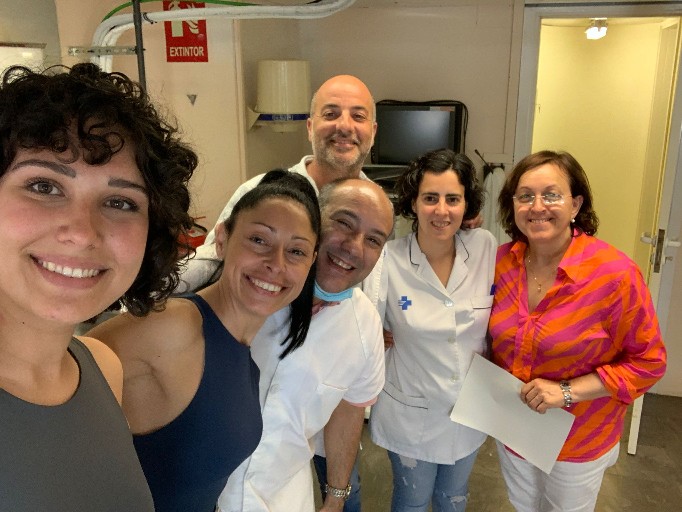
Óscar Luri (al centre de la imatge, amb la mascareta) amb els seus companys de feina del CAP Sant Pere de Reus, on treballa.
It is precisely this commitment to patients and their care that has led Dr Romero’s team to work to advance science in order to offer the most innovative, personalised and effective treatments to the people he cares for. In collaboration with the URV’s Department of Computer Engineering and Mathematics, they have developed 2 software programs (called Mira and RETIPROGRAM) based on artificial intelligence. The first is a reading algorithm that reads the patient’s data extracted from the photo of the ocular fundus taken with a retinography or non-mydriatic camera (this is the test used to detect diabetic retinopathy) and determines, for each patient, the risk of suffering from it and, if they have it, the degree of development (mild, moderate or severe). The RETIPROGRAM, on the other hand, is a predictive algorithm: it uses indicators such as the patient’s age, weight, height, blood pressure, haemoglobin level and renal status to assess how often the test should be performed in order to be well controlled. “This latest software will therefore help us to rationalise this type of test: we will do it in a personalised way, when it is determined that it is necessary to do it, and not when the healthcare system sets it as a standard.”
This technology is based on a portable device: “a retinograph, but… portable”, explain the health professionals in Dr Romero’s team.

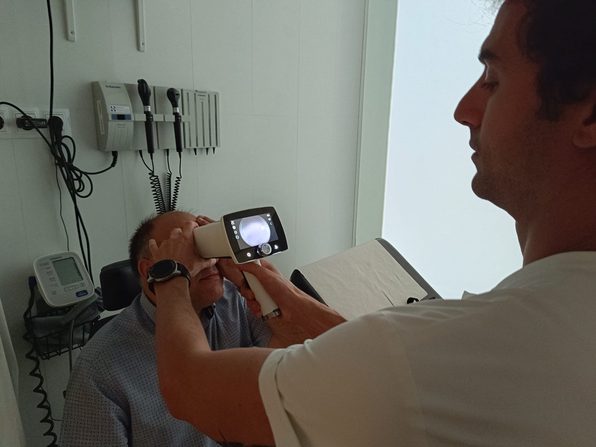
Óscar taking the fundus examination test with the “transportable retinograph” that is currently used in a pilot phase at the Sant Joan University Hospital in Reus, among other centers, and that works in accordance with the 2 registered softwares.
The test to detect diabetic retinopathy by examining the fundus of the eye is performed once a year (usually, but it depends on the patient) in certain primary care centres and hospitals, mostly in cities. Thanks to this new technology and the portable system, people with diabetes who live in rural areas or who have difficulty moving will not have to travel they will be able to be examined by their family doctor at their primary care centre.
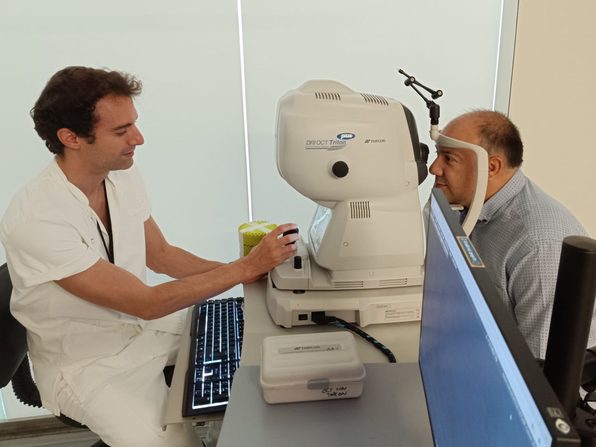
Image of a fixed retinograph, which is currently used (in some primary care centres and hospitals). This type of device allows us to detect eye conditions that cannot be seen with the naked eye, such as microneurisms or small haemorrhages.
This software and the “portable retinograph” are being used in a pilot phase at the Ophthalmology Service of the Sant Joan de Reus University Hospital and with patients from 5 of the 11 primary health care areas that we have in our territory (Cambrils, Reus, Riudoms, La Selva del Camp and Ulldemolins). It is estimated that around 14% of this population (around 30,000 people) suffer from diabetes: “In our area we only have 3 non-mydriatic retinal chambers, one of which is in our hospital. With these, we can photograph a maximum of 10,000 patients per year, no more. So there are 20,000 people we cannot reach. So we have to prioritise: RETIPROGRAM allows us to do this by stratifying these patients: we start with those who are most at risk, and for those who do not need to be photographed every year, we extend their visits,” explains Dr Romero.

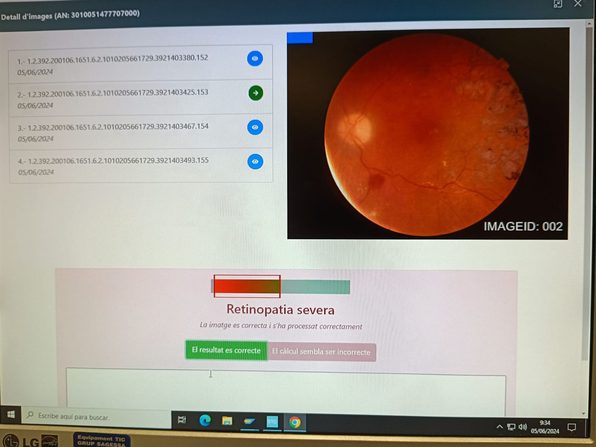
Screenshot of the Mira programme analysing the image of the fundus of a patient’s eye taken with a retinograph. In this case, the programme has detected diabetic retinopathy, which it considers to be severe.
More than 10 years of work by researchers from the IISPV and the URV in the field of diabetic retinopathy and artificial intelligence, respectively, have resulted in the creation of the spin-off company RetinaReadRisk, in which these partners are involved: the IISPV, UP2Smart (URV), Grupo TRC (Telefónica) and GENESIS Biomed. The company was created within the framework of the RetinaReadRisk project, which has received co-funding from the European Institute of Innovation and Technology (EIT) Health and the European Union under Grant Agreement 230123.
The spin-off RetinaReadRisk will be responsible for marketing the software, which will help to integrate the technology into the Catalan public health system in the future.

Project consortium
RetinaReadRisk
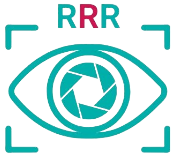
RetinaReadRisk is the spin-off created within the framework of the European project Retina Read Risk, and founded by Institut d’Investigació Sanitària Pere Virgili (IISPV), GENESIS Biomed, UP2Smart and Grupo TRC in February 2023, it aims to bring a solution to facilitate screening of diabetic retinopathy. The creation of the company emerged from a project supported by EIT Health, an aspect that also gives it an international projection. The new spin-off RetinaReadRisk benefits from more than 10 years of work from researchers and hopes to attract private and public funding in the next 2-3 years to be able to finalize the development of the product and commercialize the solution developed during Retina Read Risk project. More information
Institut d’Investigació Sanitària Pere Virgili (IISPV)
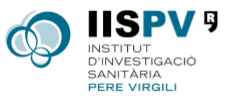
L’IISPV és un institut de recerca biomèdica situat a la província de Tarragona (Catalunya, Espanya) que combina la investigació clínica i bàsica per accelerar la translació del coneixement en benefici dels pacients. Fundat el 2005, l’institut integra l’Hospital Universitari de Tarragona Joan XIII, l’Hospital de Tortosa Verge de la Cinta, l’Hospital Universitari Sant Joan de Reus, l’Hospital Universitari Institut Pere Mata i la Universitat Rovira i Virgili, per tal d’aglutinar i gestionar la investigació biomèdica i la innovació al territori. L’IISPV pretén ser un centre de referència nacional i internacional en investigació i translació biomèdica, al servei de la població, vinculant els centres sanitaris a la comunitat. Més informació
Institut Català de la Salut (ICS)

The Catalan Institute of Health (ICS) is the largest public health services company of Catalonia with a staff of over 53,031 professionals, that provides health care to nearly six million people across the country. As a reference entity of the public health system, the aim of ICS is to improve people’s health and quality of live, through the provision of innovative and excellent health services, regarding both the promotion of health and the treatment of diseases, from the most prevalent to the most complex ones. ICS structure includes 953 primary care centres and local consultancy, 8 Hospitals and 7 research institutes, including IISPV as a one of them. Our organization mission states to be a model that, through its structure and participants, responds to projects of strategic relevance to the ICS, guaranteeing the capacity and sufficient knowledge to execute them in short terms and obtaining fast returns in the form of results and value for the organization. ICS’ vision would become a reference and reliable model for all management structures, corporate and territorial, and ICS professionals to promote innovative projects, advise on their approach and relate, if necessary, external agents that collaborate in its deployment and / or provide resources. Since mid-2021 till mid-November 2023, Mr Francesc Iglesias, responsible of the Research and Innovation support office of ICS, has been the chairman of the Governing Board of EIT Health Spain, being actually the vicechair of the EIT Health Spain foundation and Chair of INNOLIFE. More information
Telefónica
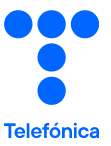
Telefónica is one of the world leaders integrated operator in the telecommunication sector, providing communication, digital services, information and entertainment solutions, with operations in 12 countries in Europe and Latin American and with a global present in 38 countries. As of the end of 2022, Telefónica’s total number of customers amounted more than 383 million and 103,000 professionals. Telefónica spends more 3.700 million euros each year on technological innovation, including more than 714 million euros on R&D of new products, services and management systems and improvement of existing ones. In the health sector, Telefonica is working in several areas like Telemedicine, geo-localised transport of living tissue between hospitals, assisted surgery operations with 5G and VR, AI applied to disease detection, etc. Més informació
Grupo TRC

Grupo TRC has over 30 years of experience working hand in hand with groups of hospitals, developing applications to optimize and integrate all activities and processes of a health center in a unified platform.
The experience in the integration of advanced telecommunications systems, in the deployment of voice operator and connectivity services and in the development of customized software, both public and private sectors, national and international, are the guarantee of the commitment to the quality of our deployments, solutions and services. More information
GENESIS Biomed

GENESIS Biomed is a consultancy firm in the biomedical healthcare sector specialized in providing consulting services in the genesis and first phases of lifecycle of biomedical spin-off and start-up companies, entrepreneurs, and research centers.
Based in its expertise GENESIS Biomed helps entrepreneurs and researchers to shape their business plan and supports them in the private fundraising process. GENESIS Biomed has raised >68,5 M€ in the last years in 20 rounds.
GENESIS Biomed expertise domains are biopharmaceutical, biotechnological, medical devices, in vitro diagnostic, nutraceutical and cosmetic. With more than 20 years of expertise in the healthcare sector, GENESIS Biomed is born in May 2017, and it is located in the Barcelona Science Park, and also with company sites in Madrid center and at La Marina in Valencia. More information
E-Senior

E-Seniors is a French non-profit association, founded in 2004 by Monique EPSTEIN. E-Seniors aims at fighting against e-exclusion by providing access to and training in ICT to seniors and/or disabled people. Its main objectives are bridging and shrinking the digital gap between generations, caring for elders by fighting against senior isolation, and opening new horizons for efficient use of free time. Besides teaching “basic computer skills”, E-Seniors has opened more thematically oriented workshops for “advanced” students, dealing with, for example, digital images and sounds, interactive messaging and chat, “writing memories”, and meetings dealing with the fight against e-exclusion. Through its work for elderly people and with them, the association tries as well to enhance awareness of the importance of ICT solutions in everyday life. More information
Fondation de l’Avenir

The Fondation de l’Avenir is a non-profit organization that funds, supports and promotes applied medical research for the benefit of patients. Created in 1987 by French mutual healthcare associations, it has been recognized as a public-interest non-profit since 1988. Today, the Foundation is the link between the mutual-healthcare movement and public health stakeholders. The Fondation de l’Avenir has more than 43,000 donors as well as 40 partners from the social and solidarity economy, working in concert to advance medical progress. The Foundation has funded more than 1,300 projects since its creation, including many world firsts. It is managed by an Executive Board, chaired by Marion Lelouvier, under the control of a Supervisory Board, chaired by Matthias Savignac. More information
EIT Health
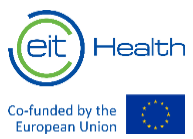
EIT Health is a network of best-in-class health innovators with approximately 130 partners and is supported by the European Institute of Innovation and Technology (EIT), a body of the European Union. We collaborate across borders to deliver new solutions that can enable European citizens to live longer, healthier lives.
As Europeans tackle the challenge of increasing chronic diseases and multi-morbidity, and seek to realise the opportunities that technology offers to move beyond conventional approaches to treatment, prevention and healthy lifestyles, we need thought leaders, innovators and efficient ways to bring innovative healthcare solutions to market. EIT Health addresses these needs. We connect all relevant healthcare players across European borders – making sure to include all sides of the “knowledge triangle”, so that innovation can happen at the intersection of research, education and business for the benefit of citizens. More information
EIT Health: Together for healthy lives in Europe.
To stay in touch with the RetinaReadRisk project, subscribe to the newsletter.
You can contact us through this email: contact@retinareadrisk.eu
The company was created within the framework of the RetinaReadRisk project, which has received co-funding from the European Institute of Innovation and Technology (EIT) Health and the European Union under Grant Agreement 230123.
Disclaimer
The RetinaReadRisk project is funded by the European Union. However, the views and opinions expressed are solely those of the author(s) and do not necessarily reflect those of the European Union or the EIT. Neither the European Union nor the authority that grants the subsidy can be considered responsible for these.